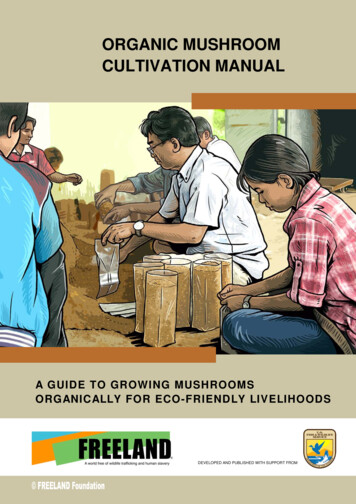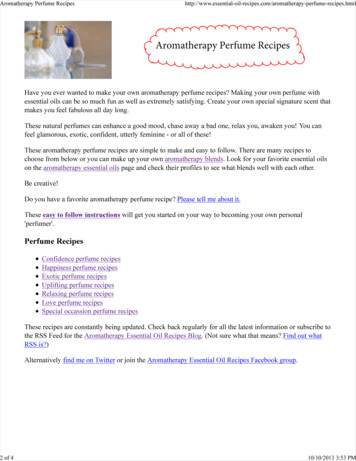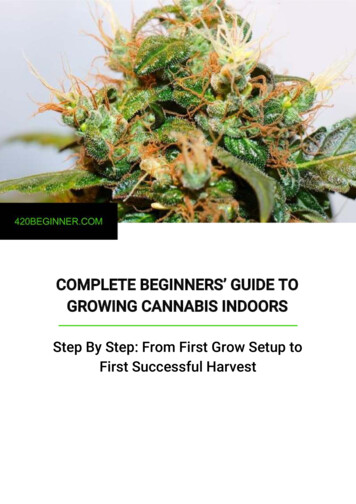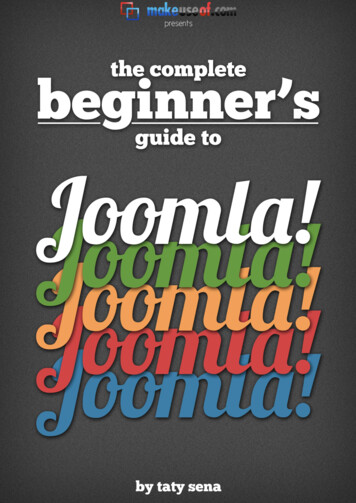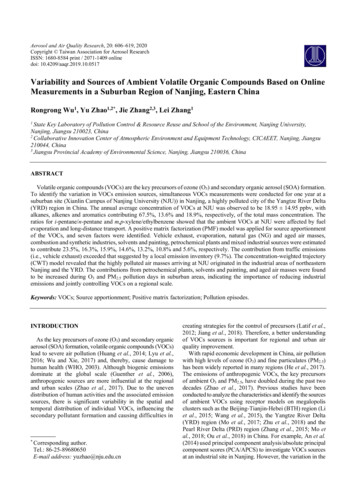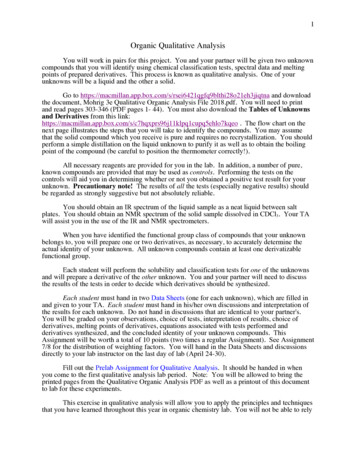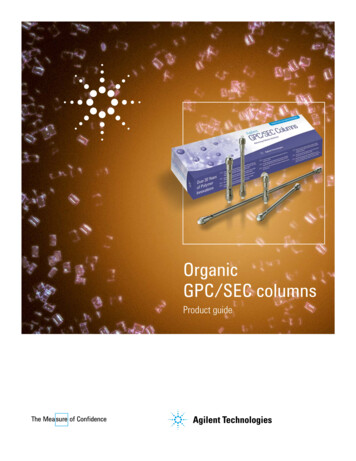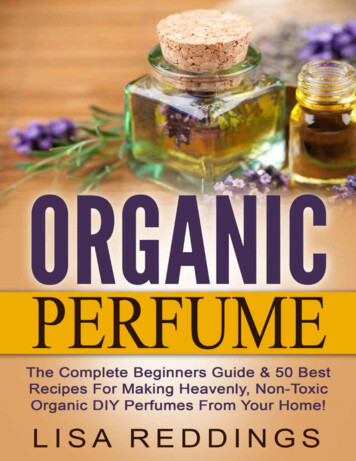
Transcription
Organic Perfume:The Complete Beginners Guide & 50Best Recipes For Making Heavenly,Non-Toxic Organic DIY PerfumesFrom Your Home!Table of ContentsIntroductionChapter 1 – What is Organic PerfumeChapter 2 – How is Organic Perfume Made?Parfum (Perfume) and CologneEspirit de Parfum/CologneEau de ParfumEau de ToiletteEau de CologneEau FraichePerfume TypesOil Based PerfumesSpray PerfumesSolid PerfumesBody SpraysPerfume PyramidBlending OilsPerfume Containers
Chapter 3 – Perfume DilutionsWater & AlcoholSolidsBase OilsChapter 4 – Essential OilsScent CategoriesChapter 5 – Essential Oil Safety InformationChapter 6 – Perfume Recipes and BlendsAlcohol/Water Based PerfumeAlcohol/Water Based CologneBase Oil PerfumeAlcohol/Oil Based Eau de PerfumeOil Based PerfumeOil/Water Based Body SpraySolid PerfumesPerfume BlendsBlends for HerFragrances for HimPerfumes with Health BenefitsEveryday BlendsConclusionBonus ChapterSoap Making: Made Easy! - How To Make Natural Soap From Scratch With 33 Organic Non-Toxic DIY Homemade Soap Recipes!Chapter 1 – Basic SoapsIntroductionInside this book you will find information on how make your own organicand natural perfume, blend oils and create amazing scents to suit yourindividual personality.
You will also discover the secrets about the hidden chemicals in commercialperfumes that the manufacturers don’t want you to know, you will learnhow to use products you can find in your local supermarket as a base foryour creations and find recipes which will enable you to wonderful gifts forfriends and family.The only thing standing in the way of you creating beautiful scents thathave added therapeutic benefits is the limit of your own imagination.Thanks again for downloading this book, I hope you enjoy it!
Chapter 1 – What is Organic PerfumeOrganic perfumes are made up from natural products and contain none ofthe additional chemicals and synthetic scents that commercial perfumes aremade from.They are manufactured using pure essential oils which not only offer anamazing variety of scents but which also contain therapeutic benefits, so inaddition to smelling great, your perfumes could also be treating anyailments or long term health conditions you may have.In contrast, many commercial perfumes can cause health problems and/orexacerbate some conditions you may already be suffering from, such asallergic reactions, headaches, hormone disruption, increased severity ofasthma or eczema conditions, thyroid complications and a suppressedimmune system.These health risks are caused by the chemicals which are included in theperfume recipes and which, because of the secrecy clauses included in themanufacture of commercially branded perfumes, are often undisclosed onthe product packaging.Many of the chemicals included are petro chemicals and are derived fromeither petroleum or natural gases, and it is around half of these chemicalswhich are not required to be disclosed. More worrying is that over 300 ofthese chemicals can be used in perfume manufacture and around 43% ofthese are untested and have no FDA approval.The scent of commercial perfumes does tend to last longer than an organicperfume but again, this is due to added fixative chemicals such as DiethylPhthalates. The possible health costs of regular use of these chemicals in theperfume you wear is extremely high and can include an increased risk ofdeveloping cancer, possible birth defects and low sperm count.An Environment Defence Group conducted a study on the presence ofchemicals in 3 new born babies. The findings showed the presence of 137chemicals. Not all of the chemicals found in the newborns are used inperfumes, however a number of them are.
Of the 137 chemicals found:132 are linked with the onset of cancer133 are linked to reproduction and development problems110 are toxic to the brain and nervous systemFor the average person who uses commercial perfumes once or twice aweek, this should cause no real problems but for those who regularly use itat least once a day it I worth remembering that around 60% of the perfumeyou wear will be absorbed into the bloodstream. As much of the perfume ismade up from chemicals, and contains very little natural scent, this is a lotof unnatural products you are absorbing and carrying around in your body.The health risks attributed to some of these chemicals include:Parabens – A synthetic preservative which is reputed to disrupt hormones.Phthalates – A preservative which is carcinogenic, (linked with cancer).Additional contraindications of phthalates include kidney and liver damage,birth defects, decrease in sperm count and premature breast development inboth male and female.Synthetic Musk’s – linked to a disruption in hormones. Traces of syntheticmusk’s have been found in umbilical cord blood from newborn babies,breast milk, body-fat and fat tissue.While some pure essential oils are not completely risk free, those that docarry restrictions, such as those not suitable during pregnancy, are nothidden and the information can be freely found. This allows your perfumesto be tailored to suit the person who will be wearing it. There is such a widerange of essential oils that it is a simple matter of substituting unsuitable oilfor a similar scent that is suitable and ensuring that any health risks areeasily avoided.
Chapter 2 – How is Organic Perfume Made?Before you begin to make your perfume you must decide what strength youwant to make, what type of perfume you would like and what sort of scentyou require. There are five different perfume strengths for feminineperfumes and three main strengths for masculine scents.Parfum (Perfume) and ColognePerfume and cologne are the strongest scented of the perfume types. Theycontain between 15 – 40% of essential oils to 60 – 85% of dilutionsubstance. As such, these are also the most expensive to purchase, but thiscost is dramatically reduced when making it yourself at home.Espirit de Parfum/CologneThis is the least common strength of commercial perfumes but works wellfor home manufacture. It is made up of between 15 – 30% of essential oilswhich allows for the option of a lower cost perfume while still retaining astrong aroma.Eau de ParfumThis strength tends to be the most popular blend as it carries much of theintensity of a full perfume but is light enough for day wear and strongenough night wear. It uses between 10 – 20% essential oils.Eau de ToiletteUsing just 5 – 15% essential oil, this is a much lighter variety than Eau deParfum and works well as a daytime scent.Eau de CologneThis is a light masculine scent which is generally used for daytime or workin place of the heavier scent of full Cologne. It is made using only 3 – 8%
essential oils, but as masculine scents tend to be fuller bodied than femininescents it is often equivalent to a feminine Eau de Toilette.Eau FraicheEau Fraiche is more of a lightly fragranced body spray than a perfume andis typically made using water or a mix of oil/water or alcohol/water. Theycontain only 1 – 3% essential oils.Perfume TypesOnce you have decided on the strength of perfume you wish to make, youneed to decide on the composition of your scent. Do you want an oil, sprayor solid perfume?Natural perfumes can be made using liquid oils such as almond or jojoba,solids such as coconut oil or Shea butter which can be mixed with a naturalwax or you can use alcohol, water or both to make spray perfumes.Oil Based PerfumesLiquid oils, (also known as carrier oils), are an inexpensive and popularchoice for natural home-made perfumes. They blend well with the essentialoils, are easy to apply and are quickly absorbed into the skin.Many carrier oils also provide their own therapeutic properties which workwell with the individual or combined properties of the essential oils beingused in your scent.Spray PerfumesThis type of fragrance is made using an alcohol base. Perfume alcohol canbe used but plain vodka works just as well and often costs considerablyless. Alternatively, if you like the aroma of a particular spirit, such asbrandy, whisky or rum, this can also be used but you must take care toensure that the alcohol scent does not override the essential oils. Also, the
overall scent of the oils will change slightly when mixed with a scentedalcohol so you will need to experiment if you would like to try this option.Caution: The alcohol will evaporate once it is in contact with the air butthis does not happen immediately so this method must be avoided if theperfume/cologne is designed for someone with a current or previous alcoholproblem.Solid PerfumesSolids are the most convenient type of perfume is you wish to carry it withyou for re-application throughout the day. They are compact and do not leakmaking them easy to slip into a bag or pocket.They are made using firm oils or butters and wax. Additionally, they areusually inexpensive to package as they require only a small tin or jar.Body SpraysThese are the most inexpensive type of perfume to make but they are alsothe lightest as they contain very small quantities of essential oils comparedwith the stronger perfumes.Most often these are made only from a blend of essential oils and water, butcan also be manufactured using a dilution mix of either carrier oil and wateror alcohol and water.Perfume PyramidAlthough it may appear as simple as mixing together a few oils with adiluting product, perfume making is actually a little more technical thanthat. All good scents contain three different layers of fragrance.Top NotesThe top note(s) form the first impression of your perfume. This is the initialsmell that either attracts or repels you, and as such, it is the most important
layer.Top notes generally evaporate within the first 20 minutes. This does notmean that their scents are removed from the overall perfume fragrance, justthat these stop being the dominant scents.Typically top notes make up 20 – 40% of your essential oils blend.Popular essential oils used for top notes are:Anise, Basil, Bay (Bay Laurel), Bergamot, Citronella, Eucalyptus,Galbanum, Grapefruit, Lavender, Lemon, Lemongrass, Lime, Orange,peppermint, Petitgrain, Spearmint, Tagetes and Tangerine.Middle NotesMid Notes make up the main component of your essential oil blend andaccount for between 40 – 80% of the oils used.The middle notes become gradually more noticeable as the top notes beginto fade. It takes around 10 minutes for the first hints to come through thetop notes and they are fully apparent after around 30 minutes. Mid notesgenerally stay dominant from up to 2 hours, (certain scents may last a littlelonger than this).Popular mid notes essential oils include:Bay, Carrot, Chamomile, Cinnamon, Clary Sage, Clove, Cypress, Dill,Fennel, Fir, Geranium, Hyssop, Jasmine, Juniper, Lindon Blossom,Marjoram, Neroli, Nutmeg, Palmarosa, Parsley, Black Pepper, Scotch Pine,Rose, Rose Geranium, Rosemary, Rosewood, Spruce, Tea Tree, Thyme,Tobacco, Yarrow, Ylang Ylang.Base NotesBase notes begin to develop around 30 minutes after the perfume is appliedand make up between 10 – 25% of the essential oil blend.These are the longest lasting scents of the fragrance blend and areresponsible for the lingering aroma of your scent long after the main smellhave disappeared.
Popular base note essential oils include:Angelica, Balsam, Beeswax, Cedarwood, Frankincense, Ginger, Myrrh,Oakmoss, Olibanum, Patchouli, Sandalwood, Vanilla, Vetiver.Blending OilsWhen you first begin choosing your own blends of essential oils it isimportant to familiarise yourself with both individual oils scents andcombined scents. Many oils smell very different when mixed with anotherand even though they appear unpleasant on their own, when blended withother scents they can create beautiful aromas. Similarly, pleasant smellingoils can take on quite unpleasant smelling characteristics if mixed with thewrong oil.Keep a notebook to hand when experimenting with blending so you canrecord what works and what does not.Start with a limit of 5 to 10 drops of oil in total and use a mixture of top,middle and base notes. Do not waste your oils by making sample blendsusing too many drops as this can lead to expensive mistakes. Once you finda blend you like you can begin to experiment further but it will save a lot ofwaste in the interim.Once you have settled on a particular blend, test it out with differentdilution mediums. All carrier oils contain their own scents andcharacteristics, some stronger than others, so if you are using oil as adilution agent you must ensure you find one that compliments youressential oil blend.Initially, use a basic essential oil ratio of 30:50:20 to get you started, thiscan then be adapted as you become more experienced. This equates to 30%top note oils, 50% middle note oils and 20% base note oils.e.g.1oz of perfume 30ml 600 dropsIf you make a 10ml oil based Eau de Parfum you will need a scent blendbetween 10 – 20%. For this example I will be using a 20% blend. This
equates to 1 part essential oil blend (2ml) and 4 parts carrier oil (8ml).There are 20 drops of essential oil per 1ml so for a 20% blend of 10ml I willneed 40 drops of oil.30% 12 drops of top notes50% 20 drops of middle notes20% 8 drops of base notesThese are then blended together and added to the 8ml of carrier oil.Perfume ContainersThere are a huge variety of containers available online for storing yourperfumes. From expensive, fancy bottles to plain and simple bottles,containers and vials, the choice is limited only by your personal taste.Vials are usually around 5ml and are great for samples. Some are clearbottles with a screw top while others have a small applicator attached to theinside of the lid.Roller Ball Bottles are perfect for oil based perfumes as they allow you tocontrol the amount you are applying. They often have screw top lids whichmake them leak proof and are inexpensive. While most are made from plainglass or plastic, it is possible to purchase decorate bottles which are greatwhen making perfumes for gifts.
Spray Atomizer Bottles are used for all alcohol or water based perfumesand can be use for very thin oil/water mixes. They range from small andplain to highly decorative so you can create some amazing perfumes thatcan be packaged very attractively.Jars and tins are perfect for solid perfumes. They are small and portable andare made from everything from tin, enamel, glass and plastic. The variety of
lids is also huge and you can obtain slide lids, screw top, clip-on andhinged.Pendant or Charm Bottles make wonderfully stylish gifts and are refillable.Typically they are between 1ml and 5ml and are available in a large varietyof designs. Quite often these pendants come with a tiny funnel designed forfilling the pendants with perfume. While these are more expensive thanregular containers, for an individual perfume gift they are definitely worththe extra cost.
Chapter 3 – Perfume DilutionsWhether you choose to use a base oil, (carrier oil), wax or an alcohol as adilution agent, it is important to understand the positive properties eachsubstance contains.This chapter describes the most popular base oils and their health benefitsalong with any contraindications as well as information on perfume alcoholand vodka as a base ingredient so you can make an informed choice whenchoosing your perfume ingredients.Water & AlcoholDistilled WaterDistilled water comes from the steam which is collected while boilingwater. Purified or filtered water can be used as an alternative to distilledwater.HydrosolHydrosol is distilled water collected from the boiling of floral waters suchas lavender infused water. This can be purchased ready-made or you canmake your own at home.Rectified SpiritRectified spirit or alcohol is an agriculturally based ethyl alcohol, (usuallygrain), which is repeatedly distilled to create a pure alcohol.The purity level of most rectified spirits is 95.6%, however this can bedifficult to purchase due to the restrictions of such a high alcohol level.A popular choice is a rectified spirit of 75.5% ABV, (151 proof) called‘Everclear’ as this is more widely available.
VodkaA clear, tasteless and odourless alcohol produced using grains or potatoes,this is the closest commercial alcohol to rectified spirit and readily availableand as such it is a great alternative. The process of distillation used inmanufacturing vodka makes it a great fixative to stabilise scent andpreserve essential oils.If using vodka aim for the highest alcohol level you can find. Remember,the higher the ABV the purer the alcohol.Perfumers AlcoholWhile this is readily available it is worth noting that it does contain 3different ingredients so is not as pure as rectified spirit or vodka.Perfumers alcohol is made up of denatured alcohol, isopropyl myristate anddipropylene glycolSolidsBeeswaxProduced by worker bees, this is a natural wax that is widely used in avariety of different industries. Beeswax has a light honey scent and itshealth properties include:Anti-inflammatoryAnti-bacterialForms a natural barrier on the skin which aids in healing and skinprotectionHumectant, (attracts water which keeps skin hydrated)Anti-allergenicSoothes itching, including eczemaVitamin AThere are different types of beeswax with the main ones available being.1. Yellow beeswax - natural product obtained from the honeycomb
2. White beeswax - yellow beeswax which has been bleached3. Beeswax absolute - yellow beeswax which has been treated withalcoholFloral WaxSolvent extracted wax with a slight fragrance. These waxes are often usedby vegans as an alternative to beeswax however they are quite expensiveand not as widely available as the beeswax option. The most popular floralwaxes are jasmine, rose and mimosa.Shea ButterShea butter comes from the Shea Nut and is widely used within thecosmetic industry. It has a slight nutty scent and its benefits include:Anti-inflammatoryMoisturizingCollagen ProductionVitamins A, D & EAnti-oxidantAnti-agingNot as stable as a wax so will not give the same solidity to your perfumebut a great option to mix with wax to create a slightly softer perfume. Thiscan also be used on its own to create a perfumed body cream.Raw (Virgin, Unrefined) Coconut OilRaw coconut oil is extracted from the kernel of a mature coconut. It has athick consistency and, unless warm, does not resemble an oil. It has alovely, mild coconut scent which can complement many essential oils.
When purchasing coconut oil it is important to ensure you do not buyrefined, bleached oil, always choose raw oil that is pure.Benefits of coconut oil include:MoisturizingAnti-ViralVitamin EAnti-AgingAnti-OxidantAnti-FungalBase OilsCarrier oils are made from vegetables, seeds, nuts and fruit. Many of theoils used as a base oil are better known in cooking however, be certain thatyou buy either unrefined, virgin or extra virgin when shopping for base oilsin the grocery store.There is a large range of different base oils so below I have listed the mostpopular oils and their benefits.
Sweet Almond OilA thick, sweet nutty oil that is highly moisturising and removes impuritiesfrom the skin. This oil does not penetrate the skin well and tends to sit onthe surface making it ideal for the treatment of dry skin conditions.Argon OilLight to medium density oil that has a nutty scent. This oil is quicklyabsorbs and very hydrating. It contains anti-aging and protective propertiesand can help with scars and stretch marks.Evening Primrose OilA light and nutty scented oil with healing and astringent properties.Evening Primrose also has anti-inflammatory benefits.Grapeseed OilA pale green oil with a light to medium density that has a mildly sweetscent. Beneficial properties include anti-aging, anti-oxidant, anti-fungal andanti-bacterial.Hazelnut OilThis is a lightly scented oil with moisturising properties. Its other benefitsinclude Skin strengthening and circulation, regenerative, astringent andsoothing.Jojoba OilJojoba is very thick, waxy oil with very little scent. Nourishing and quicklyabsorbed into the skin. It contains anti-oxidant properties.Olive OilThis is a heavy oil with a fruity scent, better known in the food industry.Olive oil penetrates the skin well and has anti-oxidant properties.Rose Hip OilRose hip is non greasy, amber coloured oil with an earthy scent. Rose hipoil is regenerative and contains anti-inflammatory properties.Sesame Oil
Yellow/brown oil with a strong nutty scent. Sesame oil has anti-agingproperties and is moisturising and soothing on the skin. It is also known toabsorb and remove toxins.Wheatgerm OilStrong scented oil with a high level of moisturising properties. It has antioxidant properties and stimulated skin regeneration.
Chapter 4 – Essential OilsIf you are willing to invest your time and energy into making your ownperfumes and scents then it is worth investing a little time to source goodquality essential oils. Low grade oils contain fewer of the beneficialproperties of high grade oils and much less strength when it comes to theirscent.This is because the plants used to obtain the oils are not of the best quality.Always choose Grade A oils and ensure you are purchasing from areputable seller.The majority of essential oils are made by extracting the oils from the plantsusing steam or water methods and these are perfectly suitable for use inyour perfume making. All recipes are based on this type of essential oil.There are two other extraction methods which are regularly used and theseproduce a higher concentration of oil.Absolutes: These are extracted using a solvent based method. This ensuresthat the oil extracted contains a high concentration of molecules making itmuch stronger than other oils.If using absolutes in your perfume making, adapt your recipe to halve oreven third the number of drops of the absolute oil.CO2’s: These are extracted using pressurised carbon dioxide making thefinished product a much thicker density than most oils. These essential oilsare ideal for perfume making as their extraction method allows them toretain a higher level of the plants natural scent.As with Absolutes, adapt your recipes quantities in the same way to allowfor the density and concentration of the oil.Bottles of essential oils typically contain between 10ml and 25ml. Due tothe high quantity of plants required to extract small amounts of oil, thesetiny bottles can often appear to be expensive.When purchasing your oils you should take into account that although thequantity you are paying for is small, 1ml of oil contains 20 drops, meaningeach 10ml bottle holds 200 drops of oil.
Absolutes and CO2’s, if undiluted, will contain the same amount of dropsbut because of the concentration, each single drop is worth 2 or 3 drops ofregular essential oil. Essential oils also have a long shelf life, typically 6 –12 months.When choosing oils to blend for your own recipes, or to alter a recipe, it isimportant to understand the different categories of scents available.Scent CategoriesFloral ScentsCinnamon Bark (Ceylon Cinnamon) – While not a true floral, cinnamonbark adds a warm and enhancing element to a floral scent. It blends wellwith frankincense and all woody scents.Geranium – Strong leafy rose scent with hints of fruit and mint.Jasmine Absolute – A honey-sweet floral oil that is very distinctive. It hasan aroma that is both calming and sensual.Lavender – Sweet, balsamic sent with floral overtones. It blends well withclary sage, patchouli, rosemary, pine and many others. Lavender isrenowned for its healing properties.Neroli – Neroli comes from the bitter orange tree and has a strong, spicyscent that is very refreshing. It works well will most floral and citrus oil andhas calming and sensual elements.Rose Absolute – A very deep, sweet and long lasting floral scent withuplifting qualities.Rose Otto – A gentler fragrance than rose absolute it is still warm andintense and works well in perfumes.Sweet Basil – a sweet, floral scent with a lightly spiced aroma. It hastherapeutic benefits which include an uplifting and energising of mood. Itblends well with Lime, Bergamot and Clary Sage.Ylang Ylang – Intense floral fragrance very similar to jasmine. Ylang Ylangis a sensual aroma that works well in Perfume and provides an upliftment to
the mood. Ylang Ylang should be used sparingly as it has strongaphrodisiac qualities.HerbExotic Basil – As with sweet basil this oil has a sweet, floral scent but withcamphor overtones. Therapeutic benefits and blending is the same as SweetBasilChamomile - Wild – This has a fresh herbal scent with sweet, long lasting,balsamic undertones. It blends well with wood and musk scents.Chamomile - Roman - A milder scent than German Chamomile that addswarm overtones when blended with clary sage, jasmine, neroli or bergamot.Chamomile - German – A sweet, fruity, almost apple like scent with hintsof tobacco. Add rich undertones to perfume blends and is long lasting.Clary Sage – Spicy, bittersweet scent with hints of hay. It has a long lastingaroma that works well as a fixative when combined with other blends.Hyssop – A strong woodland herb scent with sweet and spicy overtones. Itblends well with other herb oil and citrus oils. RefreshingSweet Marjoram – Warm and spicy scent with hints of nutmeg. Works wellin masculine blends or spicy perfumes.Palmarosa – A rose floral scent mixed with fresh grass which is veryrefreshing.Peppermint – Powerfully sweet menthol scent – best when blended withother oils.Rosewood – A sweet, woodland scent with hints of nutmeg and floral. Adda nice layer to many scent blends.CitrusBergamot – A fresh, sweet and fruity aroma with uplifting qualities thatblends well with other citrus oils.Grapefruit – Bittersweet citrus scent that is refreshing and uplifting.
Lemon – Intense lemon scent. Lemon oil can cause some irritation so use insmall quantities to enhance other scents only.Lemon Eucalyptus – A fresh and invigorating scent that has an aroma ofgrass and rose but with a hint of citrus.Lime – Very fruity and fresh oil with a strong citrus aroma. As with lemonoil, use in moderation.Mandarin – Citrus scent with floral undertones that is uplifting and sensual.Sweet Orange – A very lively scent that is sweet and fruity. This oil workswell in both masculine and feminine scents and is refreshing and uplifting.Tangerine – Very similar in scent to Mandarin oil but more suited tomasculine blends.CamphorEucalyptus – A distinct scent with a hint of menthol. Invigorating andpurifying benefits.Wild Marjoram – A strong and spicy scent that is sweet and contains a hintof eucalyptus.Peppermint – See Herb GroupRosemary – See Herb GroupTea Tree – This is a warm, spicy scent that has some medicinal undertones.Blends well with lavender, rosemary and nutmeg and creates an upliftingaroma.ResinFrankincense – Spicy, peppery, lemony and balsamic aroma that suits mostmasculine, floral and spicy blends.Myrrh – Warm and spicy with a distinct balsamic scent. This is a good oil toblend with woodland scents.Spicy
Allspice – Spicy, slightly sweet scent that works well for masculinecolognes. It blends well with orange, ginger and patchouli oils as well asother oils within the spice group. Therapeutic benefits include lifting ofmood and overall feeling of mental wellbeing.Bay – Intense fresh and spicy scent with a hint of cloves.Cardamom – A slightly camphor-like scent that is spicy with floralundertones. This oil is best suited to blends that contain floral or masculinescents.Cinnamon – See Woody GroupCoriander – Aromatic, slightly sweet and spicy scent that blends well withbergamot, cinnamon bark, jasmine and frankincense.Ginger – A warm and spicy scent with woody overtones. This oil blendsnicely with citrus oils and other spicy oils.Nutmeg – A slightly oily scent of nutmegs with a spicy overtone. Bestsuited to spicy perfumes and men’s cologne, it has an uplifting andenergising effect on the senses.EarthyPatchouli – A long lasting scent which is quite exotic with earthy, woodyand spicy tones. It has a rich, sweet balsamic scent and is quite intense. Thescent of patchouli deepens over time and is both soothing and sensual.Vetiver – Rich woody scent with hints of sweet earth. This is a long lastingscent which works well as a fixative in aromatic blends.WoodyAmyris - West Indian Sandalwood – This is a woody, balsamic scent with aslightly sweet overtone.Carrot – Sweet, earthy and woody, carrot oil provides an oriental feel tomost blends.
Cedarwood – A woody scent with balsamic overtones. This oil promotescalm during emotional stress and anxiety.Cypress – Spine with strong hints of pine, this oil blends well with clarysage, lavender and citrus oils.Juniper – Fresh and warm, juniper contains balsamic and pine wood aromasthat blend well with citrus oils and spicy oils. This oil works well inmasculine blends.Pine – A fresh scent with a resinous undertone best suited to masculinecologne. Use with caution as this oil can irritate sensitive skin.Sandalwood – Sweet, woody and warm with a balsamic scent that increaseswith age. Sandalwood blends well with the majority of oils and is sensualand relaxing.
Chapter 5 – Essential Oil Safety InformationAs essential oils are highly concentrated, their properties can be dangerousif used in amounts that are too high for our biological system so all oilsmuch be well diluted before use in perfumes.In addition, certain oils can cause reactions while others are unsuitable foruse in pregnancy and other physical conditions. Below is some health andsafety information to consider when preparing perfumes and to help in yourblending process.The following oils should be avoided as they are eyIf you suffer from any long term, serious health problems you should seekadvice from a reputable holistic or aromatherapy practitioner before usingessential oils. Below I have listed oils which should most commonly beavo
Organic Perfume: The Complete Beginners Guide & 50 Best Recipes For Making Heavenly, Non-Toxic Organic DIY Perfumes From Your Home! Tab l e of C on te n ts Introduction Chapter 1 – What is Organic Perfume Chapter 2 – How is Organic Perfume Made? Parfum (Perfume) and Cologne Espirit d
